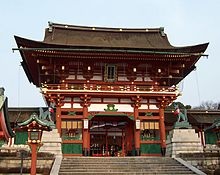|
|
| |
|
|
| |
|
|
|
|
| |
 |
| The main gate to
Fushimi Inari-taisha in Kyoto, one of the oldest
shrines in Japan. |
Shinto
Shinto (Japanese: 神道) is a form of Japanese animism.
They believe there are many Kami, translated as gods or
nature spirits. Some "kami" are just spirits of certain
places, and some are the overall "kami" (like "Amaterasu",
the Sun goddess). The word "Shinto" comes from the
Japanese words "神", shin—the word for god, and "道", tō—the
word for "the way" or "path". So, Shinto means "the way
of the gods." |
|
|
State Shinto was the main religion of Japan before World
War II. During the period 1868 to 1945 the Japanese
government used Shinto for propaganda. All Japanese were
forced to register with their local shrine. All Shinto
priests worked for the government. War was seen as a
sacred duty. The Emperor of Japan was seen as a god.
Japanese Buddhism was also involved with the war effort.
(See Zen at War) |
|
|
Shinto has many rituals and customs, and some are done
every day. Some people mix Shinto and Buddhist rituals
and beliefs. |
- Although Jinja-Honcho manages almost
all shrines, some, such as Yasukuni, are run separately.
- Amaterasu, the Sun Goddess, is seen
as the holiest of all Shinto kami. Her shrine is in Ise,
Japan.
|
|
|
|
|
|
|
|
|
|
|
|
|
|
|
|
|
|
|
Search Fun Easy English |
|
|
|
|
|
|
|
|
|
|
|
|
|
|
|
About
Contact
Copyright
Resources
Site Map |